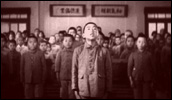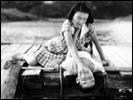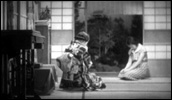Introspection Tower
- Year
- 1941
- Original title
- Mikaeri no To
- Japanese title
- みかへりの塔
- Director
- Cast
- Running time
- 111 minutes
- Published
- 15 December 2008



by Roger Macy
Hiroshi Shimizu is a director who has frequently been singled out for his undeserved neglect in the west. Jasper Sharp, of this website, made a powerful case for his revival in a review of Mr. Thank You. Keiko I. McDonald, in the conclusion to her 2000 book, From Book to Screen, promised us a whole book on Shimizu, but we have still to see the happy event [ * ]. William M. Drew, also on Midnight Eye, has given us a devoted survey of five of his silent films. But none of these films has been available in the west or with English subtitles.
However, somebody at Shochiku seems to have read Jasper's plea, as two boxed DVD sets have been released in Japan of Shimizu's films, all with English subtitles. These are careful transfers of a standard that does justice at last to a master craftsman. The English translations, also, are of high quality by credited translators. Although the packaging is entirely in Japanese, the English subtitles can be switched on from the usual button on the remote control. You need to be able to play a Region2 DVD.
Box 1 contains The Masseurs and a Woman, Mr. Thank You (thank you Shochiku - you obviously were listening), Ornamental Hairpin, and Japanese Girls at the Harbour (covered in William Drew's survey).
Box 2 has four of Shimizu's most renowned films centring on children. The earliest, Children of the Wind, was actually exhibited at Venice in 1938. There's also Nobuko and Four Seasons of Children from the following two years, as well as Introspection Tower of 1941, on which I will concentrate to give my impressions.
Introspection Tower is set entirely at a children's reformatory in a rural, agricultural setting with a railway running nearby but no station. In most respects the school has a very enlightened outlook and would stand favourable comparison with reformatories in the UK of any era I can think of. It's a very bright film (which may have helped the transfer) and shows no signs of suffering from fade. Shimizu is known to have favoured location shooting and most of the footage is of outside shots, alternating with a few intervals in the school-houses in which the children board, with just a few classroom shots. He always favoured dolly shots, observing the children from some distance and these are used extensively here to great and sympathetic effect.
Children and animals have a long pedigree of ruining actors' reputations. For me, it's obvious when a dog is over-acting but once children have got used to a sensitive director, my disbelief is not just suspended but completely captivated and I'm quite unable to see them as actors at all. Not so for the grown-ups, but mainly because there were so many recognisable faces from golden age Japanese film, most of them looking very young. There were more faces that I could recognise than name, but chief amongst the surprisingly young faces was Chishu Ryu, playing one of the teacher / housemasters.
There can be no doubt that Shimizu had a special talent for portraying the feelings and viewpoint of children, but I think it would do Shimizu an injustice to say that this film was entirely from their viewpoint, as it focuses on the difficulties of the housemasters and housemistresses - the latter are always addressed as 'okasan', 'mother'. There is a telling exchange between husband and wife late into the night, that 'this is a job without end'. Delinquent children were always reasoned with, albeit in a very directional way. There were none of the beatings that would have been common at a British reformatory of the period and the only case where a housemistress slaps a girl in her charge is a cause for deep remorse and a serious consideration of resignation.
There is not a hint that a war is on. There are no adults in uniforms, no military paraphernalia or drills, and the prospective occupations of the charges are all civilian, even bucolic. Frankly, the child-centred reformatory regime in war-time Japan came as quite a shock to me. Reform was modelled around self-reflection, peer pressure, and a responsibility to those around one - never in this film was it responsibility to an elevated group, let alone a nation.
In all fairness, I should own up that this is not how others have seen this film. Peter High, in The Imperial Screen says that "the education to which the children are subjected is quite fascistic". It is easy to see that the culture of required public self-confession has been woefully abused by totalitarian regimes - and I can think of no better example than the recently released United Red Army, where self-denunciations turn lethal. But here the self-reflections, 'introspections' of the title, show troubled children groping towards a modicum of self-awareness, contrasting so poignantly with the innocent self-centredness of their childish explorations. It's also true that education seems to entirely cease for a period when a new water-course for the reformatory is needed. But to me the film had a feel of a well-made Soviet propaganda film - praising collective action after painfully 'democratic' decision-making, requiring endless discussion until complete unanimity is obtained. This difference in political perception led me to see the subsequent montage of impassioned physical labour as owing more to Eisenstein than Riefenstahl - converging on the general line, rather than a triumph of the will. But the one muse that Shimizu stayed consistent to was his own. This is not remotely the feudal world that Japan's enemies portrayed of her at the time. Shimizu found a way, within his constraints, of another view of country life as a child's world from which, alas, all must pass.
Introspection Tower is the last of the four 'children' films in the set, made at the end of a period when he had been in favour and was given the resources to make these bright, skilfully woven films. But it's a pity they are only available at the moment in a boxed set. It's not that they are not all worth having, but it can give a UK purchaser a sting in the tail. Her Majesty's Customs and Excise regard any import over £18.50 as dutiable. And they are getting very keen to raise duty since they also get the poor individual to pay for the privilege of their 'handling' it. Individual DVDs might escape attention and would not seem such a greedy request when friends in Japan want to send a present, for which the duty threshold is considerably higher than for a direct import.
[ * ] After submitting this piece, I learned of the sad news of the death of Keiko McDonald in a fishing accident. Keiko McDonald was one of the greatest writers in the west on Japanese cinema, specialising in essays in depth on the reading of individual films. Unlike the little pointer above, her pieces were highly developed and beautifully crafted essays and, in my opinion, best read after a first viewing of the film. One of the most memorable experiences for me has been reading her essays, the day after seeing a great Japanese film, and getting a sharply enriched enhancement of the film. Fortunately for me, there remain films and essays for which I still hope for the pleasure. Fortunately for all of us, I gather her Shimizu book was at the editing stage and that we can all hope for many enriching experiences. - Roger Macy